|

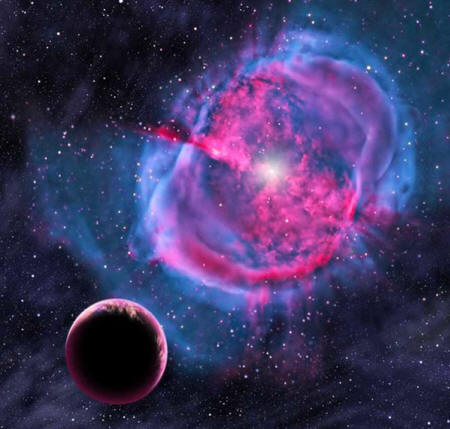
Artistís concept showing an Earth-like planet
orbiting a star that
has formed a stunning "planetary nebula."
Credit: David A. Aguilar (CfA)
8 Newfound Alien Worlds...
Could Potentially Support Life
by Mike Wall
January 06, 2015
from
Space Website
Astronomers have discovered eight
new exoplanets that may be capable
of supporting life as we know it, including what they say are the
two most Earthlike alien worlds yet found.
All eight newfound alien planets appear to orbit in their parent
stars' habitable zone - that just-right range of distances that may
allow liquid water to exist on a world's surface - and all of them
are relatively small, researchers said.
"Most of these planets have a good chance of being rocky, like
Earth," study lead author Guillermo Torres, of the
Harvard-Smithsonian Center for Astrophysics (CfA), said in a
statement.
The haul doubles the number of known habitable-zone planets that are
potentially rocky, study team members said.
The newly discovered worlds were all detected by NASA's prolific
Kepler space telescope, then confirmed using observations by other
telescopes and a computer program that assessed the statistical
probability that they are bona fide planets (as opposed to false
positives).
While none of the eight is a true "alien Earth," two of them
- known
as
Kepler-438b and
Kepler-442b - stand out for their similarities to
our home planet (though both worlds orbit red dwarfs, stars that are
smaller and dimmer than Earth's sun).
Kepler-438b, which lies 470 light-years from our solar system, is
just 12 percent wider than Earth and has a 70 percent chance of
being rocky, study team members said.
The planet completes one orbit
every 35 days and receives about 40 percent more energy from its
star than Earth does from the sun.
Kepler-442b is about one-third larger than Earth, and has a 60
percent chance of being rocky. The exoplanet's orbital period is 112
days, and it gets about two-thirds as much energy as Earth,
scientists said. Kepler-442b is about 1,100 light-years from Earth.
As intriguing as these two worlds are, there's no guarantee that
either of them could actually host life, team members stressed.
"We don't know for sure whether any of the planets in our sample are
truly habitable," co-author David Kipping, also of the CfA,
said
in the same statement.
"All we can say is that they're
promising candidates."
Such hedging is unavoidable at this point, because researchers just
don't have enough information.
For starters, there's the uncertainty
about the planets' composition, as evidenced by the estimated
rockiness probabilities. (Nobody knows for sure where the dividing
line lies between rocky and gaseous worlds, in terms of planet
size.)
Furthermore, a planet's surface temperature is highly dependent on
the composition and thickness of its atmosphere, and nothing is
known about the air surrounding Kepler-438b, Kepler-442b or any of
the other newfound worlds.
And some scientists employ a more restrictive definition of
"habitable zone" than others. Indeed, study team member Douglas
Caldwell, who presented the results today (Jan. 6) at the annual
winter meeting of the American Astronomical Society (AAS) in
Seattle, said that only three of the newly confirmed planets are
"securely" in the
habitable zone:
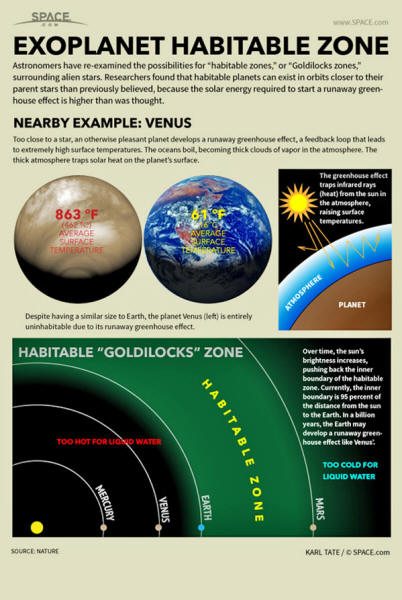
But he's not discounting the life-hosting chances of the other five.
"All of these planets are small, all of them are potentially
habitable - and, in fact, have a more than a 50 percent chance of
being in the slightly extended habitable zone - and all are
interesting," Caldwell, who's based at
the SETI (Search for
Extraterrestrial Intelligence) Institute in Mountain View,
California, said during a AAS press briefing today.
Other big exoplanet news was announced today at the AAS meeting as
well - namely, that scientists have identified 554 new planet
candidates in the Kepler mission's database, bringing the number of
total Kepler candidates to 4,175.
Just over 1,000 alien planets identified as potential worlds by
Kepler have been officially confirmed to date, but it's likely that
around 90 percent will eventually be validated, mission team members
say.
Among the newly announced 554 candidates are eight that are small
(between 1 and 2 times as wide as Earth) and orbit in their stars'
habitable zones.
Six of these eight potential planets circle a sun-like star.
"These candidates represent the closest analogues to the Earth-sun
system found to date," Fergal Mullally of the Kepler Science Office
said during today's AAS news conference.
"This is what Kepler has
been looking for. We are now closer than we have ever been to
finding a twin for the Earth around another star."
The $600 million Kepler mission launched in March 2009 to determine
how common Earthlike planets are throughout the Milky Way galaxy.
A
glitch ended the spacecraft's original planet hunt in May 2013, but
researchers are still combing through Kepler's huge database. (The
554 new candidates were pulled from observations made between May
2009 and April 2013.)
And last year, Kepler embarked upon a new, two-year mission called
K2, during which the observatory is searching for planets in a more
limited fashion and is also studying supernova explosions, star
clusters and other cosmic objects and phenomena.
Kepler has discovered more than half of all known exoplanets.
The
total alien-planet tally currently hovers around 1,800; the number
differs slightly depending on which database is consulted.
1,000 Alien Planets!
-
NASA's Kepler Space Telescope Hits Big
Milestone -
by Mike Wall
January 07, 2015
from
LiveScience Website
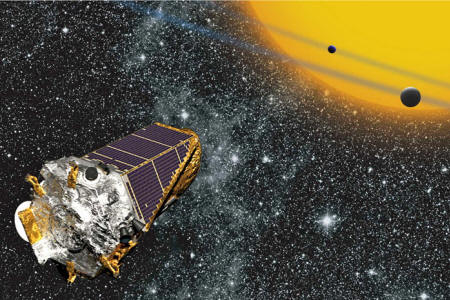
An artist's illustration of NASA's Kepler space telescope
observing
alien planets in deep space using the transit method.
The space
observatory has discovered more than 1,000 alien planets
since its
launch in March 2009.
Credit: NASA Ames/ W Stenzel
NASA's
Kepler spacecraft has discovered its 1,000th alien planet,
further cementing the prolific exoplanet-hunting mission's status as
a space-science legend.
Kepler reached the milestone today (Jan. 6) with the announcement of
eight newly confirmed exoplanets, bringing the mission's current
alien world tally to 1,004.
Kepler has found more than half of all
known exoplanets to date, and the numbers will keep rolling in:
The
telescope has also spotted 3,200 additional planet candidates, and
about 90 percent of them should end up being confirmed, mission
scientists say.
Furthermore, a number of these future finds are likely to be small,
rocky worlds with temperate, relatively hospitable surface
conditions - in other worlds, planets a lot like Earth.
(In fact, at
least two of the newly confirmed eight Kepler planets - which were
announced in Seattle today during the annual winter meeting of the
American Astronomical Society - appear to meet that description,
mission team members said.)
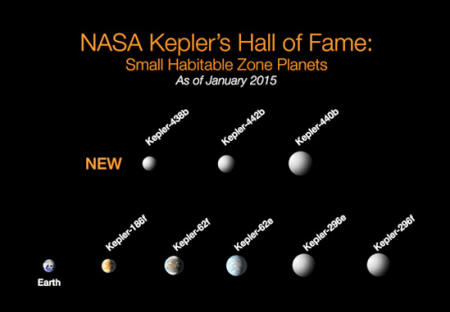
NASA's exoplanet-hunting Kepler space telescope
has
discovered more than 1,000 alien planets,
including the eight small,
potentially habitable worlds here.
Scientists announced Kepler's
1,000-planet milestone on Jan. 6, 2015.
Credit: NASA
"Kepler was designed to find these Earth analogues, and we always
knew that the most interesting results would come at the end,"
Kepler mission scientist Natalie Batalha, of NASA's Ames Research
Center in Moffett Field, California, told Space.com last month.
"So we're just kind of ramping up toward those most interesting
results," she added.
"There's still a lot of good science to come
out of Kepler."
Changing the game
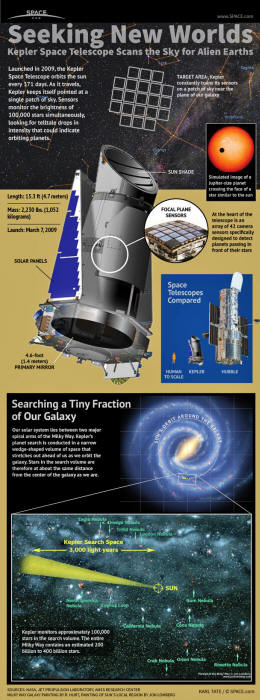
The mission of the Kepler Space Telescope
is to identify and
characterize Earth-size planets
in the 'habitable zones' of nearby
stars.
Credit: Karl Tate
SPACE.com contributor
Exoplanet science is a young field.
The first world beyond our solar
system wasn't confirmed until 1992, and astronomers first found
alien planets around a sun-like star in 1995.
The Kepler spacecraft has therefore been a revelation, and has
helped lead a revolution. The $600 million mission launched in March
2009, with the aim of determining how frequently Earth-like planets
occur around the Milky Way galaxy.
The telescope spots alien planets using the "transit method,"
watching for the telltale brightness dips caused when an orbiting
planet crosses the face of its host star from Kepler's perspective.
The instrument generally needs to observe multiple transits to flag
a planet candidate, which is part of the reason why the most
intriguing finds are expected to come relatively late in the
mission.
(Several transits of a huge, close-orbiting "hot Jupiter,"
which has no potential to host life, can be observed relatively
quickly, while it may take years to gather the required data for a
more distantly orbiting, possibly Earth-like world.)
"Before, we were just kind of plucking the low-hanging fruit, and
now we're getting down into the weeds, and things are getting a
little harder," Batalha said.
"But that's a challenge we knew we
would have."
Kepler candidates must then be confirmed
- by follow-up observations
using other instruments, for example, or by rigorous analysis of the Kepler dataset.
That enormous dataset has allowed researchers to study alien planets
in new systematic and statistical ways.
In 2013, for example, two
different studies used Kepler data to estimate the percentage of red
dwarfs - stars smaller and dimmer than the sun - that host
Earth-size planets in their "habitable zone" (the range of distances
from a star that could support the existence of liquid water).
One study put the number at 15 percent, while the other calculated
40 percent. Even the lower estimate should cheer astrobiologists,
for red dwarfs are the most common stars in the Milky Way, making up
about 70 percent of the galaxy's 100 billion or so stars.
Kepler has not yet discovered a true Earth twin - an Earth-size
planet in the habitable zone of a sunlike star - but the mission is
on track to figure out just how commonly these worlds occur
throughout the galaxy, Natalie Batalha said.
"I don't yet have a good sense of the completeness of the habitable
zone; it could be that we will be sensitive toward the inner half of
the habitable zone, maybe not the complete habitable zone," she
said.
"But I am confident now that we are going to get a number
based on actual discoveries, and that we are not going to have to
rely on extrapolation."
A new mission
Kepler's original planet-hunting campaign, which was designed to
last for 3.5 years, called for the spacecraft to continuously
monitor about 150,000 distant stars in the constellations
Lyra and
Cygnus.
The data-gathering part of that mission came to an end in May 2013,
when the second of Kepler's four orientation-maintaining reaction
wheels failed, robbing the spacecraft of its super-precise pointing
ability.
A repair mission is not going to happen; Kepler orbits the
sun, not the Earth.
But Kepler is still observing the heavens.
In May 2014, NASA
approved a new two-year
mission extension called K2 for the space
observatory, during which a compromised Kepler continues to hunt for
exoplanets but also observes other cosmic objects and phenomena,
including supernova explosions and star clusters.
K2 should spot a number of relatively nearby exoplanets that can be
observed in detail by NASA's $8.8 billion James Webb Space Telescope
(JWST), which is scheduled to launch in late 2018, Batalha said.
"So we will be well-poised when JWST launches to begin studying the
diversity of the atmospheres of planets, thanks to discoveries made
by K2," she said.
(NASA's Transiting Exoplanet Survey Satellite, or
TESS, scheduled to launch in 2017, should also find a number of
promising targets for follow-up work by JWST, researchers say.)
While K2 observations continue, Batalha and other Kepler scientists
are still busy analyzing data from the prime mission.
NASA wants
this work done by September 2017, and the team should meet that
deadline, Batalha said.
"Sometime around September of 2016, we'll probably have our final
catalog," she said.
"And then between September and January [of
2017], we'll be producing the products that will allow people to do
the statistics with the catalog. And then we'll kind of write up all
of our documentation and final papers, and turn off the lights and
go home sometime around the end of summer 2017."
But that moment won't mark the end of Kepler's contributions; NASA
could extend K2 for another two years, for example.
And even if the
spacecraft shuts its sensitive eyes in 2016, its observations will
keep researchers busy for a long time to come.
"I fully expect that scientists will be working through Kepler data
- and characterizing those planets and inferring various properties
of exoplanets based on that data - literally for decades," Batalha
said.
|





